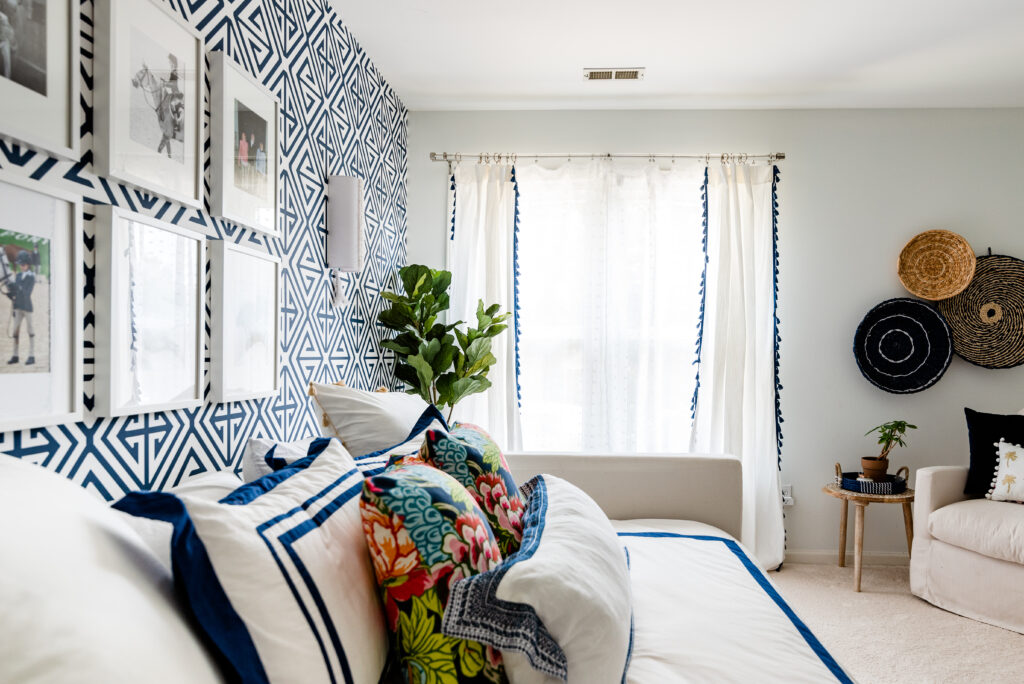Demystifying Draperies and Other Window Coverings
October 20, 2022

When you hear the word “draperies”, are you confused? Isn’t it just a fancy word for curtains? The short answer is yes and no. Read on to learn all about window coverings, what kind you need and the differences between them.
Curtains vs. Drapes. I would say that this one is the most confusing. They look so similiar! Here’s how I differentiate between the two – Drapes are lined, curtains are not. It’s as simple as that. I 100% prefer drapes for their aesthetic purposes and their light control. With drapes, they are typically custom made so you can choose the precise length, your own fabric, what type of pleat you want at the top and whether or not they are decorative or functional. If they are functional drapes, meaning you can pull them shut for privacy and light control, you can choose how much light control you want from the lining. Curtains are typically just panels without a lining so they definitely can’t be used for light control, but they can aid with privacy and are usually more affordable. Curtains are mostly store bought and come in 12″ long increments.
Different Types of Shades Well, this one packs a lot of information….. decorative shades such as Roman shades are fabric shades that are functional but beautiful. I don’t recommend Roman shades for every day use, but I do love their look. I would put them all over my house if I could! You can choose your fabric, your pleat style, add trim if you want, all of the fun things! There are more functional types of shades too. Woven shades are beautiful wooden or bamboo shades that are great for privacy and are usually used with drapery panels. Roller shades are very functional and work best for light control as they are not very aesthetically pleasing. I like them for bedrooms so that they can be lowered at night for darkness.
Decorative Valences and Cornices These are purely decorative items for the window. They are used mostly to cover unsightly shade controls by covering only the top portion of a window in order to hide any hardware. Cornices are typically custom made but valences can be store bought or custom. Valences are made purely out of fabric while cornices are a mix of wood and upholstery material.
I hope this helps when a designer starts talking about window treatments. It can get confusing! The number one thing to remember is that designers feel that window treatments are very important. They add an element to a room that nothing else can add. They assist with light control, draw attention to beautiful windows and views and complete a space.
How To Mix Fabric Patterns Like a Pro
This is one of those frequently asked design questions that stumps even the most design savvy homeowners. How do I mix fabric patterns? Unfortunately, if you look online for articles and tutorials, the most resounding answer is “there are no rules!” or “rules are meant to be broken!” That doesn’t help anybody….
Here are the rules I live by when choosing a suite of fabrics for my clients.
– Keep a common color. That doesn’t mean you can only have 1 color, but it does mean that all of the fabrics in the scheme should have at least 1 color in common. Even if one of the fabrics has the tiniest hint of that color in it, you are still OK!
– Watch your scale. Scale is the size of the pattern and how it relates to other pattern sizes. And I have a rule of 3 that I like to apply when it comes to mixing scale. You need one large scale pattern, one medium scale pattern and one small scale pattern. Solids and stripes are freebies!
– Space it out. If you love 2 different patterns of the same scale and don’t want to part with either one, you can still do it. Just space them out! Perhaps put one on the sofa with the other pillows and one on a chair or on a piece of furniture that is across the room.
– Solids and stripes are freebies! I said it above but I can’t stress this enough. Solids and stripes kind of go with any pattern, as long as you are abiding by rule #1.
– Follow 60-30-10. Have you ever heard of 60-30-10? It’s a pretty simple principle – keep the patterns layered so that one is 60% of the design, another is 30% of the design and the last one is 10%. This goes for choosing a fabric suite for an entire room including accent furniture, draperies and throw pillows. For example, if I found a pattern that I LOVE, I’d use it 60% and then layer in the others accordingly.